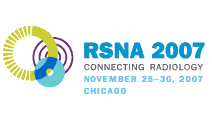
Abstract Archives of the RSNA, 2007
Lawrence Patrick Panych PhD, Presenter: Nothing to Disclose
Joseph R. Roebuck MD, PhD, Abstract Co-Author: Nothing to Disclose
Robert Vincent Mulkern PhD, Abstract Co-Author: Nothing to Disclose
Bruno Madore PhD, Abstract Co-Author: Nothing to Disclose
Nankuei Chen PhD, Abstract Co-Author: Nothing to Disclose
To develop and test a new method for improving spatial localization of prostate MR spectra and thereby reduce out-of-voxel lipid contamination.
A MR spectroscopic imaging (MRSI) sequence was modified to implement a new spatial encoding method that permits manipulation of the point-spread function (PSF). Alteration of the RF excitation is the main feature of the modifications whereby an arbitrary PSF can be obtained to significantly reduce or eliminate trunction (ringing) artifact and improve spatial localization. This is achieved with no increase in imaging time, no loss of spatial resolution, and no decrease in SNR.
Phantom experiments were conducted on a 1.5T GE MRI system to evaluate the ability of the method to reduce truncation artifact. A cospherical phantom containing a solution of choline, creatine and citrate on the inside and water on the outside was used. Single slice MRSI experiments were conducted to compare the performance of the unmodified MRSI sequence to the new sequence, which was modified to give a Gaussian point-spread function.
Patient studies were also done to evaluate the feasibility of the method. Patients undergoing evaluation for prostate cancer were recruited. Two single slice axial MRSI acquisitions were obtained. The first acquisition was obtained using the product MRSI sequence. The second acquisition, at the same slice location, was obtained using the modified sequence.
Phantom data was analyzed as to degree of signal leakage between compartments. There was a significant reduction or total elimination of signal leaking from the other compartment with no reduction in spectral quality. MRSI studies with patients demonstrated feasibility of the method in reducing lipid contamination.
Phantom and human patient MRSI experiments demonstrate the feasibility of a new method for improving spatial localization and significantly reducing or eliminating truncation artifact. Work supported by U41RR019703 and R21CA011092.
By reducing the contamination from out-of-voxel lipid signal in MRSI, our approach can significantly enhance the power of MR spectroscopy as a diagnostic tool for prostate cancer diagnosis.
Panych, L,
Roebuck, J,
Mulkern, R,
Madore, B,
Chen, N,
A New Method for Improving Spatial Socalization in MR Spectroscopic Imaging of the Prostate. Radiological Society of North America 2007 Scientific Assembly and Annual Meeting, November 25 - November 30, 2007 ,Chicago IL.
http://archive.rsna.org/2007/5010627.html

